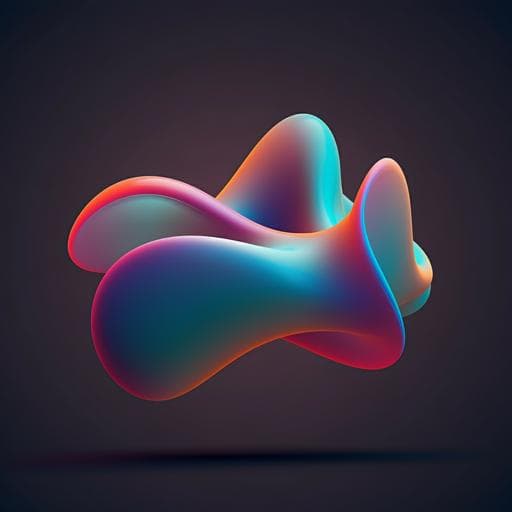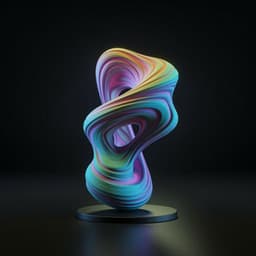
Engineering and Technology
Single-vat single-cure grayscale digital light processing 3D printing of materials with large property difference and high stretchability
L. Yue, S. M. Montgomery, et al.
Unlock the potential of multimaterial additive manufacturing! Discover how Liang Yue and colleagues have innovatively developed a resin design strategy for grayscale digital light processing 3D printing, creating structures that combine high stretchability with stiffness in a single layer. This research opens doors to applications in biomimetic designs, inflatable soft robots, and more.
~3 min • Beginner • English
Introduction
Additive manufacturing enables complex geometries and material distributions, but creating parts with both highly stretchable soft regions and stiff regions in a single efficient process remains difficult. Popular multimaterial approaches like inkjet printing (IJP) and direct ink writing (DIW) face material limitations (low stretchability) or process drawbacks (slow speed, lower accuracy, multi-nozzle complexity), and multi-method workflows are inefficient. Digital light processing (DLP) is fast and high-resolution but typically uses a single vat, limiting multimaterial capability; multi-vat methods introduce contamination risks and slow printing, while single-vat dual-initiator approaches require multiple light sources and careful alignment with limited tunability. Grayscale DLP (g-DLP) can locally control degree of cure (DoC) via light intensity, but prior systems often need dual curing (with long thermal post-cures) and still show limited stretchability. This study aims to create a single-vat, single-cure g-DLP resin system that enables continuous tuning from a highly stretchable organogel to a stiff thermoset within a single print, achieving very large modulus contrast alongside extreme stretchability at high print speed, and to demonstrate functional structures (biomimetic, inflatable, and sensing) enabled by this capability.
Literature Review
Prior multimaterial AM strategies include: (1) Inkjet printing with multiple inks, which is costly and often limited to materials that fail at low-to-moderate strain; (2) DIW with mixed materials or multiple nozzles, which is slower and less accurate; (3) Hybrid multi-step processes combining methods (e.g., DIW fibers on molded/printed elastomers) to achieve multimaterials but with limited efficiency and complexity. In DLP, multi-vat approaches allow multiple materials but suffer from vat switching, cleaning, risk of cross-contamination, and limited number of achievable properties. Single-vat multimaterial DLP using multiple initiators and light sources demonstrated feasibility but relies on precise optical alignment and offers limited property tuning. g-DLP emerged to control local DoC via pixel-wise intensity modulation, enabling property gradation and color within a single resin. A prior two-stage g-DLP resin (BPADA/GMA/Jeffamine) achieved ~1000× modulus span after a long thermal cure but had low soft-state stretchability (<35%). Single-cure g-DLP attempts based on conversion variation generally struggled to combine both high property contrast and high stretchability. These gaps motivate a resin strategy that leverages monomer interactions (hydrogen bonding) at low DoC to form tough, stretchable organogels, while achieving stiff thermosets at high DoC, all in a single-cure, single-vat g-DLP process.
Methodology
Resin design and preparation: A photocurable resin was formulated to enable wide tunability in mechanical properties via DoC control. The mixture comprises 2‑hydroxyethyl acrylate (2‑HEA), isobornyl acrylate (IBOA), and aliphatic urethane diacrylate (AUD; Ebecryl 8413) in a 20:60:20 weight ratio. Photoinitiator Irgacure 819 was added at 1 wt% and photoabsorber Sudan I at 0.05 wt%. The ink viscosity is ~0.05 Pa·s. AUD (a viscous oligomer) and 2-HEA provide abundant hydrogen-bonding sites (H–N…O and O–H…O), while IBOA raises Tg at high DoC for stiffness. Hydrogen bonding at low DoC imparts organogel-like elasticity and stretchability; at high DoC, the network becomes a stiff glassy thermoset.
Printing setup and slicing: A bottom-up DLP printer with a 385 nm UV-LED projector (PRO4500) and a linear translation stage (Thorlabs LTS150) was used. The resin vat employed an oxygen-permeable Teflon AF-2400 window to facilitate continuous liquid interface production (CLIP). 3D models were sliced into 0.05 mm layers and converted to grayscale image files (MATLAB). Exposure time was 3 s per layer, achieving a build rate of ~1 mm/min. Printer light intensity was calibrated with a photometer (ILT1400-A).
Grayscale–intensity–DoC mapping: Grayscale levels control local intensity and thus DoC within each layer. Grayscale GO (0% darkness) corresponds to full intensity (24.4 mW/cm²) yielding ~94% DoC (FTIR at 809 cm⁻¹), while G70 (70% darkness) corresponds to ~1.4 mW/cm² yielding ~55% DoC. A photopolymerization model related exposure to depth-dependent DoC and guided selection of grayscale range (GO to G70) to balance print speed and fidelity.
Mechanical/thermal characterization: Uniaxial tensile tests (MTS Insight 10, 5 mm/min) and DMA (TA Q800, 10 °C/min) characterized modulus, stretchability, toughness, and thermomechanical response across grayscale levels. Tearing tests evaluated fracture toughness (J/m²). Gel fraction for low-DoC samples (organogels) was measured (~40% for G60, ~25% for G70). Cyclic tensile fatigue (up to 10,000 cycles at 200–300% strain) assessed resilience and hysteresis. FTIR quantified DoC via normalized 809 cm⁻¹ acrylate peak.
Control resins and bonding role: A control resin lacking 2‑HEA (only AUD and IBOA) at similar DoC showed rubbery behavior but markedly lower elongation at break and poorer recovery after cycling, evidencing 2‑HEA’s contribution via hydrogen bonding. Another control replacing AUD/2‑HEA with PEGDA (Mw ~700) and BA, without strong hydrogen bonding, produced weak, low-stiffness, low-stretchability samples at low DoC, confirming the need for monomer–network interactions for organogel performance.
Adhesion and graded interfaces: Interfaces between stiff (GO) and soft (G60) regions were tested; the energy to break the interface exceeded that needed to fracture the soft domain, indicating strong interfacial adhesion. A pixel-scale transition layer (50–100 µm) exists due to diffusion and grayscale transition.
Demonstrators and simulations: Diverse structures were printed to validate functionality: anisotropic composites (stiff fibers in soft matrix), airless tires, artery-mimetic tubes with helical stiff fibers (tunable J-shaped stress–strain), and sequentially deforming composites using multiple grayscale levels. Biomimetic devices (heart valve with soft flaps and rigid frame; fish fin with stiff rays and soft membrane) were characterized experimentally and by finite element analysis (pressure loading on flaps or base). Inflatable structures were fabricated with embedded stiff elements in soft airtight matrices and tested at ~30 kPa internal pressure, including patterned membranes and pneumatic actuators realizing extension, bending, contraction, and twisting; a tentacle-like actuator combined motions for grasping.
Sensors: Strain and pressure sensors were created by printing soft matrices (e.g., G60/G70) with embedded microfluidic channels (0.4–0.8 mm diameter), filled post-print with eutectic gallium–indium (EGaIn). Resistance changes (ΔR/R0) under stretch (up to 200% strain) or applied pressure were measured; structural regions outside membranes were printed stiff (GO) to localize deformation. A finger-mounted sensor demonstrated wearable human–machine interface capabilities with higher sensitivity using smaller channels.
Shape-memory and graded Tg: Structures with graded properties exhibited a continuous Tg transition (approximately −90 to −10 °C). Samples were thermomechanically programmed at 90 °C into temporary shapes, fixed by rapid cooling, and showed sequential free recovery upon reheating (e.g., 80 °C water) consistent with property gradation.
Key Findings
- Single-vat, single-cure g-DLP resin enables continuous tuning from soft organogel to stiff thermoset by modulating local light intensity (DoC) within single layers.
- Achieved a modulus range from 0.016 MPa (G70, ~55% DoC) to 478 MPa (GO, ~94% DoC), an ~30,000× difference; soft-state stretchability up to ~1500% (G60–G70).
- Stiff state exhibits toughness ~109 J/m³; tear test fracture toughness 650–10,000 J/m² across conditions. Gel fraction ~40% (G60) and ~25% (G70). Soft organogels retained elasticity and resilience over 10,000 stretch cycles at 200–300% strain; control formulations without hydrogen bonding showed inferior elongation and recovery.
- Rapid printing retained: CLIP-based bottom-up DLP at 3 s per 50 µm layer (~1 mm/min); multiple parts printed simultaneously (e.g., 12 tentacle actuators in one batch).
- Strong adhesion between property domains; interfacial fracture required more energy than failure of the soft domain.
- Functional demonstrations:
• Anisotropic composites with embedded stiff fibers; airless tire with rigid hub and rubbery outer ring.
• Artery-mimetic tubes with helical stiff fibers exhibiting J-shaped stress–strain; tunable behavior via fiber pitch.
• Sequential deformation composites using multiple grayscale levels (G46/G56/G66) showing time-delayed section strains.
• Biomimetic heart valve (rigid frame, soft flaps) and fish fin (stiff rays, soft membrane) matched well by FEA.
• Nacre- and Bouligand-inspired architectures increased fracture toughness to 166 and 146 kPa·m^0.5 vs 42 kPa·m^0.5 for bulk.
• Inflatable structures at ~30 kPa: pufferfish with >30× volume expansion of soft belly; patterned membranes with tailored inflations; pneumatic actuators achieving extension, bending, contraction, twisting; tentacle-like gripper capable of grasping objects.
• Stretchable sensors: liquid-metal microfluidic strain gauges (to 200% strain), pressure sensors with stiffness-tunable membranes, and wearable finger sensor (0.4 mm channel) for human–machine interfaces.
Discussion
The work addresses the long-standing challenge of producing monolithic 3D prints that combine highly contrasted properties—extreme stretchability and high stiffness—without multi-vat or multi-step processes. The resin formulation leverages hydrogen bonding between partially cured networks and residual monomers to form robust organogels at low DoC, while inclusion of stiff IBOA raises Tg at high DoC to deliver glassy thermosets. By controlling DoC via grayscale intensity, the approach yields continuous property gradation and strong interfacial adhesion within a single print and cure. Retaining standard DLP hardware and CLIP allows high speed and scalability, enabling rapid prototyping of complex, functional devices. Demonstrations across composites, biomimetics, soft pneumatics, and sensors showcase the practical relevance and versatility. The results validate that grayscale photopolymerization, paired with rational resin chemistry, can create functional, multi-property parts efficiently, offering a material-centric solution to multimaterial AM for soft robotics, flexible electronics, and biomedical models.
Conclusion
A single-vat, single-cure g-DLP resin system was developed that enables unprecedented property tuning within monolithic 3D prints, spanning modulus from 0.016 to 478 MPa (~30,000×) and soft-state stretchability up to ~1500%, while maintaining high print speed (~1 mm/min). Through intensity-controlled DoC and hydrogen-bond-enabled organogel behavior, the method overcomes prior trade-offs between property contrast and stretchability. Functional prototypes—including biomimetic valves and fins, nacre/Bouligand tough composites, inflatable robotic actuators, and wearable sensors—demonstrate broad applicability. Future work may extend the chemistry to other interaction mechanisms (ion–dipole, π–π stacking), reduce pixel-scale transition widths and xy distortion via optics/algorithms/materials, and employ secondary chemistries (e.g., amine–acrylate Michael addition) to consume residual acrylates for long-term stability while preserving as-printed property gradients when desired.
Limitations
- Thermal sensitivity of low-DoC organogel regions: elevated temperatures weaken hydrogen bonding and can volatilize the liquid phase.
- Pixel-scale transition layer (~50–100 µm) between soft and stiff domains limits micro-scale feature fidelity; smaller pixel projectors, grayscale compensation algorithms, or higher photoabsorber content could mitigate.
- Low grayscale exposures cause xy size distortion, affecting microscale resolution; increasing projected area for low grayscale or computational corrections can help.
- UV sensitivity: residual acrylates in low-DoC regions may further cure under subsequent UV exposure, diminishing property contrast; a second-stage curing (e.g., amine–acrylate Michael addition using flexible polyamines) is proposed to stabilize properties.
Related Publications
Explore these studies to deepen your understanding of the subject.







